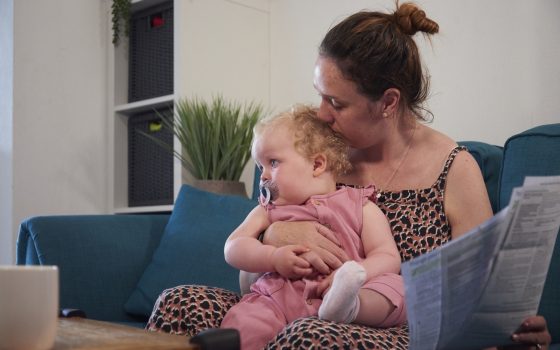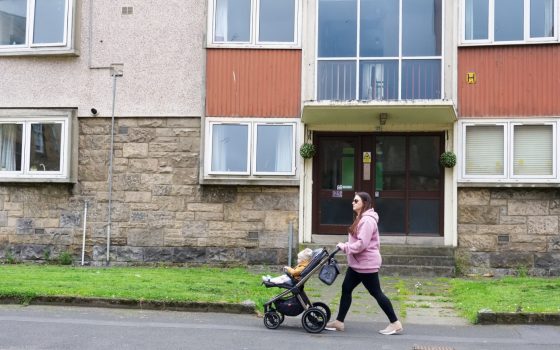Helping people into good jobs rather than just any job could save the government billions
The government’s current approach is pushing people into lower paid jobs that leave many with inadequate and insecure incomes
09 April 2024
In recent years, the guiding mantra of the Department for Work and Pensions (DWP) when it comes to supporting people into work has been ‘ABC’ – “Any job first, a Better job next and into a Career”. In reality, the government’s approach is too often pushing people into lower paid jobs that leave many with inadequate and insecure incomes. This ultimately increases the longer-term financial support required from the state, the opposite of what the government has set out to do.
By flipping its approach and focusing instead on supporting people into jobs which are more suited to an individual’s skills, experience and ambitions, the government could not only help people lead more fulfilling and rewarding lives, it could also reinvest significant additional tax revenue and savings from universal credit (UC).
Currently, the progression from ‘any job’ into a better job and then a career is more of an assumption than something the DWP is actively facilitating. People required to attend jobcentre appointments often report a culture where little attention is paid to their longer-term ambitions around work:
“If you’re going out looking for your job yourself, you’re going to pick a better job or one that’s more suited for you. But in the jobcentre, they just tell you to pick as many jobs as possible and apply for them: ‘I don’t care what you do, what your skills are, what you’re interested in. Just apply for them and hit this quota so that I can sign you off and I’ve done my bit and received my pay cheque.’ I feel like it’s very much a numbers game for them because you have to just apply and apply and apply.” – Interviewee in NEF research on women’s experiences of the social security system
Conditionality (the expectations people are required to meet to retain their benefits) explicitly enforces this approach. One condition of receiving support means people are allowed just one month to focus on jobs in their preferred sectors before they are required to apply for any position suggested by their work coach.
The reach of conditionality has been increased over time, including to more single parents through the lone parent obligation. This was declared a success by DWP but has since been shown to have primarily led to low-paid and insecure jobs. Other research indicates that more than half of people (55%) in work and in receipt of UC are in severely insecure work – a combination of elements such as low or variable pay, part-time work and underemployment.
If harsh and prescriptive conditions push people into low-quality, short-term jobs that result in frequent periods out of work, the scarring effects of unemployment can be compounded, reducing future career and living standards prospects. Stress and anxiety from poor interactions with the jobcentre can have a negative impact on people’s mental health, pushing them further from the labour market. Likewise, sanctions that drive people into destitution can further weaken their employment outcomes.
More widely, conditions on benefits can undermine people’s trust in the jobcentre and DWP, reducing the chance of genuine engagement with support. It is likely that this approach is also loosening the lower end of the labour market by making more people search for and take up poorer-paid, less secure and less suitable jobs. This means lower-paid workers have reduced influence over their pay and conditions, suppressing earnings growth and diminishing the returns to government of employment support.
Changing conditions for low earners
The interactions people have with the benefits system are in flux. The minimum earnings necessary to avoid the threat of sanctions is rising while the time allowed to find the right job has been lowered. Alongside the broad real-terms cuts to working-age social security since 2010, a decade long transformation of social security has seen legacy benefits replaced by UC.
This rollout of UC as the main working-age benefit is almost complete, with the penultimate stage of managed migration, now referred to as the move to UC, expected to end this year. As of December 2023, 520,000 families had been informed they need to apply for UC or risk their support ending. Almost all were in receipt of tax credits. An additional 440,000 notices are expected to be sent by September 2024 to some of the remaining legacy caseload. Approximately 600,000 households in receipt of income-related employment and support allowance (ESA) will be moved onto UC from 2028/29 onwards.
Figure 1: Managed migration is bringing a wave of middle-age adults into the scope of conditionality
As well as presenting a potential change in how much support people will receive (following initial transitional protection), the move to UC will also change many people’s interactions with the benefits system. 73% of those that have been sent a migration notice are over 40 and will now face stringent conditions on their claim (figure 1). So far, one in five (19%) of closed claims (those that have moved onto UC or had their previous claim closed) have resulted in a family not claiming UC, substantially more than the DWP’s initial assumption of 3%. The latest estimate is that 26% of families in receipt of tax credits only and 4% of those in receipt of other legacy benefits will not move onto UC, instead seeing their support end.
Early research by Ipsos for DWP found some explanations for those not moving onto UC, including perceived stigma of claiming UC, that they didn’t believe the migration notice applied to them, and that their support would be small and not worth the greater interaction with DWP.
Indeed, changes to the conditions people face, such as the expectation to meet with work coaches or take on work that doesn’t fit with their current living arrangements, may result in some people ending their support, reducing their income and leaving them more susceptible to income shocks. While this may be an option for some, such as those with minor savings, most will have little choice but to comply with the conditions placed on them by their work coach. Those who fall short of these expectations will find themselves pushed to take any job going, particularly impacting the 39,000 over 50s that have moved onto UC with a higher chance of a skills mismatch.
Unlike UC, tax credits contain no expectations of hours worked beyond the minimum levels necessary for eligibility. For single parents this is 16 hours per week. Under UC a lone parent is expected to work up to 30 hours per week once their youngest child turns three, increasing to 35 hours once they reach 13. Sanctions are also not present in the tax credits system, with an incentive feature instead for those working over 30 hours.
The conditions placed for those on UC and in work have also increased in recent years. Someone earning less than the administrative earnings threshold (AET) will be placed in the intensive work search (IWS) regime, comprising the greatest work search expectations. In 2022/23 the AET for a single person increased from £355 per month to £677, or 15 hours worked per week at the national living wage (NLW). For couples, the AET increased from £567 per month to £988, a combined 24 hours per week at the NLW.
While welcome, the substantial increases to the NLW in recent years have led to large hikes in the AET. From April 2024 these thresholds will be £743 and £1,189. This will have the greatest impact on someone working one of the 366,000 jobs underpaying the NLW or with a higher hourly pay and working less hours. The AET is set to be increased further, with yet to be implemented changes from the 2023 Spring budget increasing the single person AET to 18 hours and the couple’s AET set to be scrapped altogether.
The increased requirements for people in receipt of UC have coincided with reduced time to find appropriate work. Someone placed into the IWS used to have three months to find a job of their choice, with earnings above the AET, before facing the risk of sanctions to push them into any job. This was reduced to four weeks in early 2022 without any evidence base being provided in support. At the time of the policy change, the social security advisory committee noted that they had not been presented with any analysis of the potential negative impact of this policy. Indeed, no evaluation of the change has been conducted to date. In fact, the DWP rarely evaluates the impact of its policy changes, at least publicly, despite owning a wealth of data on household incomes and peoples’ interactions with the labour market.
Findings from the wider literature imply these changes are unlikely to have positive impacts. Conditionality has been found to have little effect in supporting people into work or onto better paid roles, with intermittent work common for those that do find a job. Employers are also sceptical of the efficacy of ‘ABC’, instead preferring an approach to employment support that better matches people to work based on their skills and circumstances.
The cost of conditionality to government
The government has argued that allowing people more flexibility over their work search creates costs because they spend longer out of work. But this ignores the longer-term impact of someone potentially ending up in a better and more secure job, the undesirable outcomes have followed when conditionality has been tightened on lone parents in the past, and the concerns employers have expressed about people being pushed towards poorly-matched job vacancies. In the absence of DWP data on work trajectories, in this section we explore a few examples of how much could be reinvested into social security through a better system of employment support.
The next figure presents three possible illustrative work trajectories for someone on UC to demonstrate this point. The green line shows the monthly savings to government if someone on UC does just enough to not have regular meetings with a work coach by earning at their conditionality earnings threshold – 35 hours of work per week at the national living wage (NLW). While there are early savings to government, the work they have found in the one-month since claiming UC is low-quality and not well suited to their experience or commitments. As a result, they spend the next three years cycling in- and out t‑of ‑work. The next scenario, in blue, assumes this person is given longer to find a suitable role. They find long-term work paying the real living wage (RLW), increasing tax revenue and reducing UC spend.
Figure 2: Government can save more by helping people into better jobs, even if they spend longer searching for the right role
The red trajectory is similar, starting with full-time work paying the RLW. This job is an even better match and after 18 months they have been promoted. While their initial work search was longer (at six months), government savings going forwards are more than double that of full-time work at the NLW. While only illustrative, these trajectories show that focusing more on supporting people towards good jobs rather than just any job could result in long-term savings to government.
Figure 3: Government will spend more in the long-run if any job, better job, career fails to support people into sustained work with progression opportunities
In two years, the full-time RLW trajectory (the blue line in figure 2) will save the government more than three years of someone working full-time at the NLW but with short periods of unemployment (figure 3). After three years the higher paying role found after a three-month search will save the government the same amount as finding a permanent NLW role after a one-month search. The savings to government after three years are 40% and 85% higher in the six-month work search scenario than under the sustained and intermittent NLW trajectories.
The government could make significant savings by supporting people who are working and receiving UC into better jobs. Government would save £1,230 per year by helping someone working full-time in receipt of UC to increase their hourly pay by just one pound, assuming their eligibility for UC does not end with their higher earnings. This person’s annual take home income would increase by £590. Extending this to say 500,000 of the 2.4m people on UC and in-work would save the government £620m in 2024/25 alone (figure 4).
There are greater potential gains to government by implementing a more effective, tailored approach to employment support, as part of a package of interventions that includes greater UC adequacy, pushing up the reservation wage — the lowest wage someone is willing to accept in a job. As a thought experiment, consider a policy objective to align the wage distribution of those receiving support from social security with that of other low-and middle-earners. This would require shifting the median hourly pay for someone working and in receipt of UC, or on working tax credits, from £10.50 in 2023 to £13.70, based on NEF analysis of the labour force survey. Achieving this shift would reduce annual UC expenditure by £1.9bn, with tax revenue up by £2.4bn.
Materialising this total saving of over £4bn is not an easy task, particularly given that currently just one in six people escape low pay. It will require a joint effort by local government and other government departments beyond DWP, as well as employers and unions. But it will be far harder if the government fails to reform the DWP’s ’any job’ approach.
Figure 4: Improving the earnings of half a million in-work UC recipients by just £1 per hour could save the government £620 million per year
There are substantial financial gains to be made for families and the government if DWP and the jobcentre can more effectively support people who are unemployed or on low earnings onto a path towards better pay. But the current ‘ABC’ approach is not working. As part of work towards a living income, NEF has called for a more supportive relationship between work coaches and people, focusing on genuine engagement rather than compliance underpinned by a harsh approach to conditionality. In the coming months we will be expanding on how this shift can be achieved, highlighting the experience of those navigating the benefits system and exploring public receptiveness to an alternative approach.
Image: iStock
Topics Social security Work & pay






